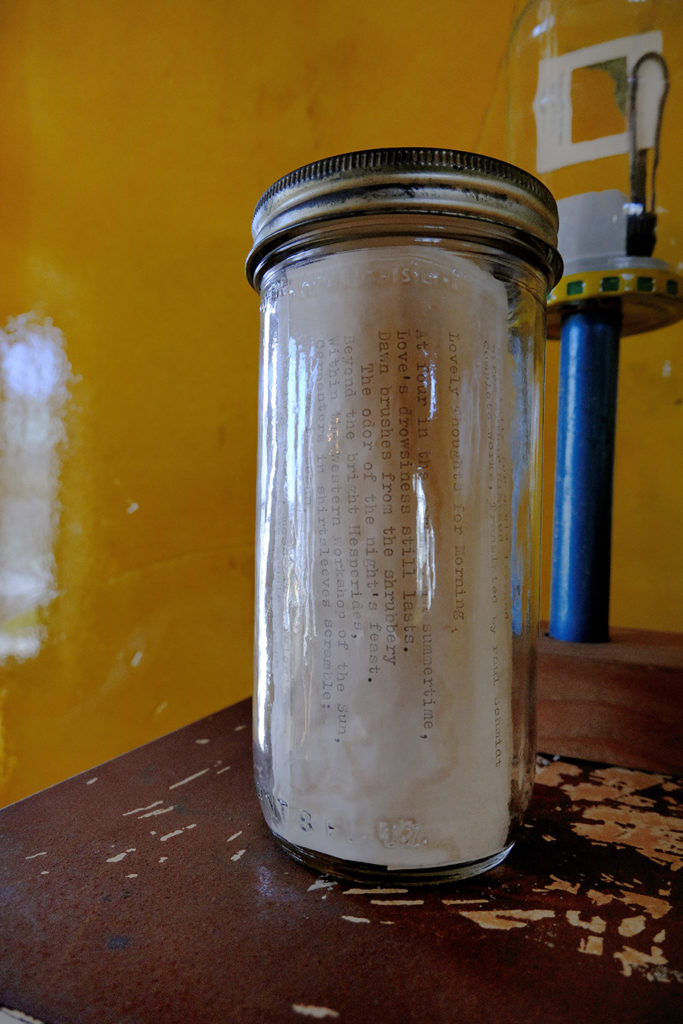Interpreting The House as it Lives

Almost tripping, I read the plaque on the sidewalk outside of The David Ireland House, “Art lets us make observations of things that were always there.”1 Walking up and down Twentieth Street a few months before moving to the Bay Area, I was visiting Oakland to help install the second leg of Basic Essentials, an exchange exhibition examining the way we attach our public and private selves to everyday objects. Think about this: a Gerber daisy, a milk jug, a ready-to-hand object. These everyday materials hold power to provide us with either a sense of belonging or isolation. In my bedroom, I wake up to a print from a show by artist Brandon Forrest Frederick. It is a photograph of the artist and Frederick’s partner, Olivia Clanton whose arm is extended out before a perfect midwestern sunset bursting like a b-roll background of pinks and lilacs. She is gently clutching an empty ice cream bucket that reads Family Size.2. In the gallery, this image lived in a frame Frederick crafted to backlight the image from the inside out. Rather than justifying our need to care for ourselves, Frederick’s work is an affirmation and a tender kind of fanaticism.

Dissecting the white noise of everyday life further draws attention to how we aestheticize objects beyond their use-value. When we are tired we may look behind the shells of what we find essential and share in a moment of grace and goof. Walking through David’s house, I think about this and how these two artists share ideas across the generational divide in how they ask us to seek meaning embedded in our surroundings. For instance, when looking at the dollar bill hung out to dry above the kitchen sink (to launder the money), or when I walk through the back hallway and mistake my reflection for something else, something otherworldly swims in the pools of light.
Dedication to the contin-
uum of the culture might
be folly.3
Directly across from the copper window is a jar, amongst other jars, sitting on a shelf in the left corner of the room as one enters from the stairwell. Most of the jars contain questionable material left unexplained by a guide if there isn’t a question from a visitor. There is a sheet of looseleaf typewriter paper In one particular jar on which is a translation of an Arthur Rimbaud poem from his hallucinatory memoir, A Season in Hell.
“At four in the morning, in summertime,
Love’s drowsiness still lasts…
The bushes blow away the odor
Of the night’s feast.
Beyond the bright Hesperides,
Within the western workshop of the Sun,
Carpenters scramble – in shirtsleeves –
Work is begun.
And in desolate, moss-grown isles
They raise their precious panels
Where the city
Will paint a hollow sky
For these charming dabblers in the arts
Who labor for a King in Babylon,
Venus! Leave for a moment
Lovers’ haloed hearts.
O Queen of Shepherds!
Carry the purest eau-de-vie
To these workmen while they rest
And take their bath at noonday, in the sea”4

Arthur Rimbaud wrote this at the age of nineteen in a caravan of trickstery pinning butterflies to his pants and shouting from the rooftops. Rimbaud always left a reader with the notion that artists must search within themselves to become seers. This happens “through a long, immense, and reasoned derangement of all the senses.”5 As a writer, he took on the task of stealing fire whereas David would play with scale and the heat of things. I have never been to The David Ireland House before ten o’clock in the morning, but with fog rolling around the house, I like to imagine it as hazy, between dream logic and waking reason. Standing in the arch that bisects the front parlor room I had a dizzying daydream that started to fill the space. David has just lit the chandelier, the two cobalt blue propane tanks kiss and out of thin air Arthur Rimbaud is back from the dead. Arthur starts to dance around the two leather chairs, singing a story about climbing trees. David starts to build, and as he does, Arthur tosses him pieces of kindling that he catches with one hand behind his back. When the fires built, the two sat down, and slowly Arthur sprouted wings, and he levitated up to the ceiling and circled the chandelier.
- “David Ireland House,” Read the Plaque, accessed June 15, 2020, https://readtheplaque.com/plaque/david-ireland-house [↩]
- Brandon Forrest Frederick, “Isle Views,” Brandon Forrest Frederick, 2018, https://www.brandonforrestfrederick.com/isle-views/hxy30o4z01sq6itjnvfjbmpx0v6cty [↩]
- Diego Villalobos and Bob Linder, “The David Ireland House,” Open Space – Field Notes, May 1, 2017, https://openspace.sfmoma.org/2017/05/the-david-ireland-house/ [↩]
- “A Pleasant Thought for the Morning” Arthur Rimbaud, Wyatt Alexander Mason, and Arthur Rimbaud, A Season in Hell ; & Illuminations (New York: Modern Library, 2005 [↩]
- Rimbaud, Arthur. Good Reads. April 29, 2011. Arthur Rimbaud https://www.goodreads.com/quotes/375362-the-first-study-for-the-man-who-wants-to-be#:~:text=%E2%80%9CThe%20first%20study%20for%20the%20man%20who%20wants%20to%20be,seer%2C%20make%20oneself%20a%20seer. [↩]
Camile e. Messerley (She/They) is an artist, writer, and arts organizer from Omaha, Nebraska currently residing in Oakland, California. Messerley graduated from the Kansas City Art Institute in 2018 with a double major in Art History and Filmmaking. Messerley is an Artist Guide at The David Ireland House and co-director of the roaming artist lecture series, The Painting Salon.

